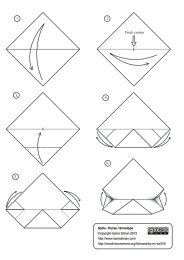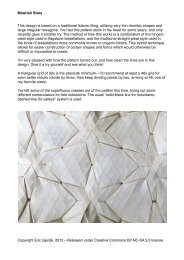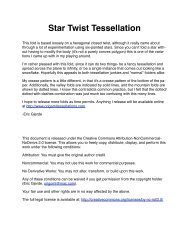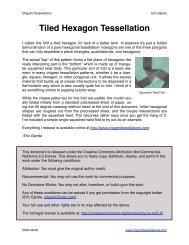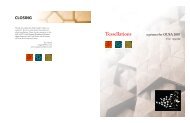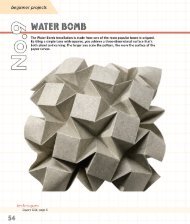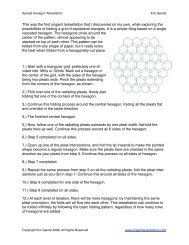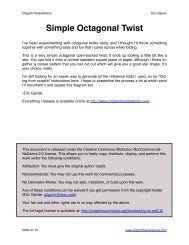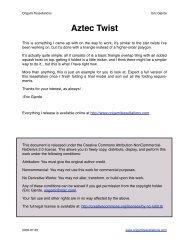Double Pleat Hexagonal Tessellation - Origami Tessellations
Double Pleat Hexagonal Tessellation - Origami Tessellations
Double Pleat Hexagonal Tessellation - Origami Tessellations
Create successful ePaper yourself
Turn your PDF publications into a flip-book with our unique Google optimized e-Paper software.
<strong>Origami</strong> <strong>Tessellation</strong>s<br />
Eric Gjerde<br />
<strong>Double</strong> <strong>Pleat</strong> <strong>Hexagonal</strong> <strong>Tessellation</strong><br />
Most tessellations created with precreased grid structures tend to<br />
use single pleats in their construction. This pattern is a bit different,<br />
using what I prefer to call double pleats to put a new spin on<br />
a very common design. <strong>Double</strong> pleats (a pleat axis with a pleat of<br />
equal width on each side) change the nature of twist folds slightly;<br />
since there is folded pleat material on both sides of the pleat intersection,<br />
there is no longer any rotational orientation that is required<br />
for the tessellation to fold flat. This handy nature of double<br />
pleats is particularly useful when tessellating patterns that have<br />
an odd number of sides, like triangles or pentagons. In this instance,<br />
however, we are using our new freedom from specific<br />
twist rotation to put a counter-clockwise spin on every triangle<br />
twist- something that would be impossible to do if we were using<br />
single pleats.<br />
single pleat<br />
double pleat<br />
The basic structure of this design is simple regular hexagons, also<br />
known as a p6 tiling or 6.6.6 tiling. We will use double pleats to outline<br />
all of the hexagons, and use triangular twists at all of the pleat<br />
intersection points.<br />
A crease pattern is attached for reference; however, I encourage<br />
you to try folding this design on your own, first. Good luck!<br />
basic structure<br />
This document is released under the Creative Commons Attribution-NonCommercial<br />
2.0 license. This allows you to freely copy, distribute, display, and perform this work<br />
under the following conditions:<br />
Attribution: You must give the original author credit.<br />
Noncommercial: You may not use this work for commercial purposes.<br />
Any of these conditions can be waived if you get permission from the copyright<br />
holder (Eric Gjerde, origomi@mac.com).<br />
Your fair use and other rights are in no way affected by the above.<br />
The full legal license is available at: http://creativecommons.org/licenses/by-nc/2.0/<br />
2006-08-24 www.origamitessellations.com
<strong>Origami</strong> <strong>Tessellation</strong>s<br />
Eric Gjerde<br />
1 2 3<br />
4 5 6<br />
7 8 9<br />
2006-08-24 www.origamitessellations.com
<strong>Origami</strong> <strong>Tessellation</strong>s<br />
Eric Gjerde<br />
1. Fold double pleats into a triangular intersection, and start pulling the extra pleat paper<br />
together at the intersection point.<br />
2. Completed intersection, prior to twisting.<br />
3. Rotate and squash twist the triangular intersection.<br />
4. Completed twist intersection, as seen from the back. Notice the lack of directionalitya<br />
single pleat twist would have one side “higher” than the other. With the double<br />
pleats, both sides are equally matched and appear level.<br />
5. Travel down one of the double pleats and create another intersection; to create this<br />
particular pattern, the center of the intersection point should be two triangle lengths<br />
away from the tip of the previous triangular twist.<br />
6. Completed second twist.<br />
7. Continue around the hexagon, creating triangular intersections and twisting them,<br />
until the hexagon is complete.<br />
8. Repeat the same process in all directions. It is easier (in my opinion) to finish one<br />
hexagon completely before moving on to another one.<br />
9. The finished pattern from the back. Notice the even tiling, and complete lack of directional<br />
orientation to the pleats<br />
and tiles.<br />
10.The finished tessellation, with all<br />
the triangular twists rotated in the<br />
same direction. (Hopefully your<br />
finished piece is more accurate<br />
than this example!)<br />
10<br />
2006-08-24 www.origamitessellations.com





